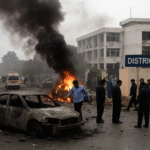Climate change has intensified extreme weather events, bringing frequent floods, unpredictable rainfall, and rising temperatures that threaten global agriculture. The ripple effects go beyond farms, affecting food security, rural livelihoods, national economies, and international trade. Here’s a clear look at the physical and economic consequences and what governments must do to secure the future of farming.
🔍 Physical Effects of Weather Change and Floods on Agriculture
1. Soil Erosion and Fertility Loss
Floodwaters strip away nutrient-rich topsoil, reducing crop yields. Waterlogging creates oxygen-poor soils, damaging root systems and slowing plant growth.
2. Crop Destruction and Delayed Sowing
Torrential rains and prolonged flooding destroy standing crops and disrupt seasonal planting schedules, especially for rice, wheat, and cotton.
3. Livestock and Fisheries Losses
Millions of farm animals perish during severe floods, cutting off income for rural families and reducing food supply chains.
4. Increased Pest and Disease Outbreaks
Warm, humid conditions after floods create a breeding ground for plant pathogens and livestock diseases, threatening both crops and animal health.
💰 Economic Impact: From Fields to National GDP
- Billions in Losses: Between 2008 and 2018, floods cost the agriculture sector $21 billion globally, with 19% of all crop and livestock damage caused by floods.
- Pakistan 2022 Floods: Damages exceeded $30 billion, affecting 33 million people and shrinking the agriculture sector by nearly 1% of GDP.
- Food Inflation: Nigeria saw a 23% spike in food prices in 2022 floods, while Bangladesh’s historic 1998 floods wiped out 575,000 hectares of crops.
- Global Cropland at Risk: Around 24% of agricultural land worldwide is in flood-prone regions, making climate adaptation urgent.
- Gendered Impact: Female-led households lose up to 8% more income in heatwaves and 3% more during floods, widening inequality in rural communities.
🌾 Broader Implications
- Food Security Threat: Crop shortages lead to price spikes, hunger, and higher import dependency.
- Rural Poverty: Farmers take loans to recover losses, deepening debt cycles.
- National Instability: Climate disasters strain government budgets, slow GDP growth, and trigger migration from rural areas.
- Climateflation: Weather shocks push global food prices higher, disrupting diets and consumer spending patterns worldwide.
🏛️ Government Action Plan
🔹 Immediate Relief
- Emergency shelters, food, and medicine for affected families.
- Veterinary support and livestock vaccination to prevent disease outbreaks.
- Cash transfers and subsidies for small farmers.
🔹 Recovery & Rehabilitation
- Repair irrigation systems, roads, and flood-control embankments.
- Introduce affordable crop and livestock insurance schemes.
- Offer low-interest recovery loans to rebuild rural economies.
🔹 Long-Term Climate Resilience
- Flood-Resistant Infrastructure: Build modern drainage systems, levees, and storage dams.
- Climate-Resilient Farming: Encourage drought- and flood-tolerant seeds, crop diversification, and smart irrigation (drip, sprinkler).
- Early Warning Systems: Use AI-powered weather forecasts and satellite imagery for early disaster alerts.
- Land-Use Regulation: Limit farming and construction in high-risk floodplains.
- Agroforestry & Soil Health: Plant trees along waterways and adopt regenerative agriculture to strengthen ecosystems.
- Farmer Education: Expand climate-smart farming programs to build rural capacity and disaster preparedness.
🔑 Conclusion
The impact of weather change and floods on agriculture is a growing challenge that threatens food security, farmer livelihoods, and economic stability. Governments must transition from reactive disaster relief to proactive climate adaptation strategies, investing in resilient infrastructure, insurance, and modern farming practices. With climate change accelerating, sustainable agriculture is not just an option—it’s a necessity for survival.










